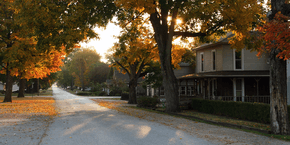Middle America (United States)
Middle America is a colloquial term for the United States heartland, especially the culturally rural and suburban areas of the United States, typically the Midwestern and Southern United States.

Middle America is generally used as both a geographic and cultural label, suggesting a Central United States small town or suburb where most people are middle class or upper middle class, Evangelical or Mainline Protestant, and typically Northwestern European Americans or of general Northern European descent, particularly Anglo-Saxon Protestant, Ulster Scot, or Germanic descent.[1]
As a geographical label
Geographically, the label Middle America refers to the territory between the East Coast of the United States (particularly the northeast) and the West Coast. The term has been used in some cases to refer to the inland portions of coastal states, especially if they are rural. Alternately, the term is used to describe the central United States.
As a cultural label
Middle America is contrasted with the more culturally progressive urban areas of the country, particularly, those of the East and West Coasts. The conservative values considered typical of Middle America (often called "family values" in American politics) are often called "Middle American values".[2][3]
The plots of such American films as Sweet Home Alabama and The Judge center on the contrast between big city life and that of a typical "Middle America" small town; in both, a protagonist with a successful big city career is drawn back to an old hometown. Similarly, the protagonist of John Grisham's novel The Associate leaves a well-paid job at a giant Wall Street law firm and goes to work with his lawyer father in his hometown, York, Pennsylvania. The contrast between "Middle America" and big city America is evident in the life of the fictional superhero Superman – growing up as Superboy in the archetypal Smallville and as an adult moving to the equally archetypal Metropolis. The depiction of Ron Kovic's childhood in the early parts of Born on the Fourth of July also fits the cultural perceptions of "Middle America" (though Kovic's hometown, Massapequa, is physically located in Long Island). The same applies to the episode of Ayn Rand's novel The Fountainhead which is set in Clayton, Ohio[4] and which depicts that town as the archetype of "Middle America", the polar opposite of the cosmopolitan New York City where most of the novel's plot takes place.
Recently, there has been a diversification in the demographics traditionally attributed to Middle America. Individuals and families of various ethnic backgrounds, including Asians and Hispanics, have started to reside in small towns in various interior states,[5] including, but not limited to, Oklahoma, Kansas, Ohio and Missouri.
Economy

Historically, the economy of Middle America has been supported by agricultural worker and industry labor.[6] Historically, housing prices tend to be significantly less volatile than those on the coasts, and houses tend to appreciate in value more slowly, the late 2000s mortgage crisis notwithstanding.[7]
Politics
The phrase Middle American values is a political cliché; like family values, it refers to more traditional or conservative politics. However, across the United States and more recently in the South, metropolitan areas and major university towns tend to be politically and socially progressive. Examples of such metropolitan areas include Chicago, Illinois; Columbus, Ohio; and Minneapolis, Minnesota, and major university towns include Madison, Wisconsin; Champaign, Illinois; Bloomington, Indiana; Lawrence, Kansas; and Ann Arbor, Michigan.[8]
Many political battleground states are situated in "Middle America."[7]
See also
| Look up bicoastal in Wiktionary, the free dictionary. |
References
- Bramlett, Matthew (April 4, 2016). "Author explores white male anger in Middle America". Claremont Courier. Retrieved June 11, 2016.
- "Comment: editorials, opinion and columns". The Daily Telegraph. Telegraph Media Group. Retrieved October 30, 2012.
- "Time: Middle Americans". Chnm.gmu.edu. January 5, 1970. Retrieved October 30, 2012.
- The Fountainhead, Part III, Ch. 4.
- Lee, Barrett; Hook, Jennifer Van. "Diversity is on the rise in urban and rural communities, and it's here to stay". The Conversation. Retrieved August 14, 2019.
- "Outline of the U.S. Economy". usa.usembassy.de.
- Paul Jankowski (April 18, 2012). "Six Ignorant Stereotypes About Middle America". Forbes. Retrieved October 30, 2012.
- Gabriel Winant (May 17, 2010). "Who's more condescending to Middle America?". Salon.com. Retrieved May 29, 2015.
| Wikimedia Commons has media related to Middle America (United States). |